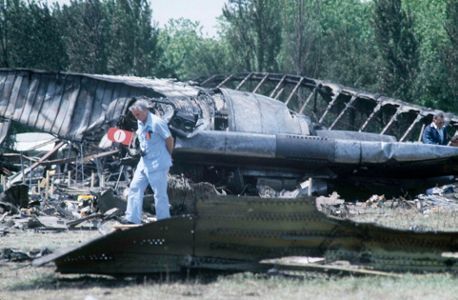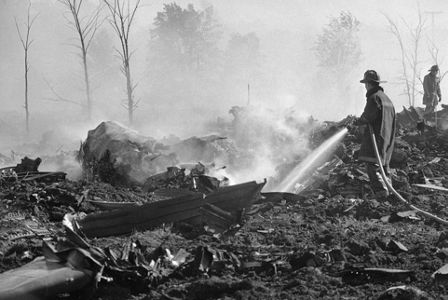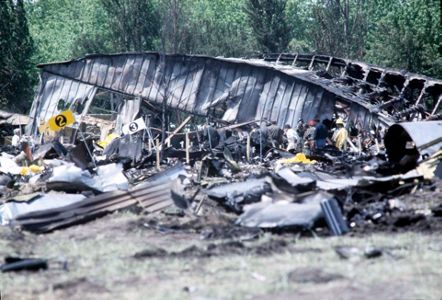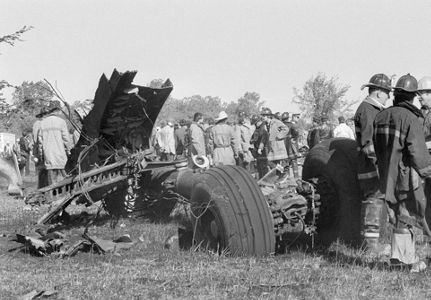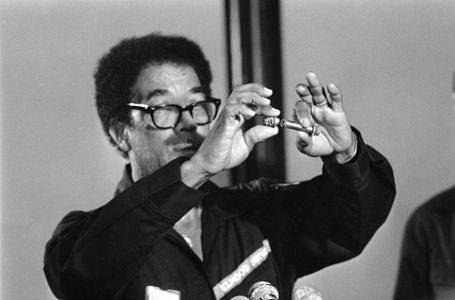CHICAGO (AP) — Decades after American Airlines Flight 191 crashed moments after taking off from Chicago's O'Hare International Airport, it remains the deadliest aviation accident in U.S. history.
The DC-10 was destined for Los Angeles when it lost one of its engines on May 25, 1979, killing 273 people, including all 271 people onboard and two others on the ground. More lives were lost in the Sept. 11 airplane crashes, but those crashes are classified as acts of terrorism, not accidents.
Reporter Marc Wilson covered the Chicago crash for The Associated Press. In a first-person account published about a week later, he described the burning debris and seeing policemen throw up, priests recoil from the touch of superheated bodies and the first body bags being loaded onto trucks to be taken to a temporary airport morgue.
"More body bags were used than there were bodies," Wilson wrote, adding that he dreamed for the three nights after the accident that he was aboard the plane.
The AP is republishing Wilson's original report to mark the 40th anniversary of the disaster.
___
An American Airlines wide-bodied jet loaded with 270 Memorial Day weekend travelers crashed nose first and broke apart in flames yesterday just after takeoff from O'Hare International Airport. Authorities said all aboard were killed in the worst air disaster in U.S. history.
Seconds before the Los Angeles-bound DC-10 jetliner crashed, one of its three engines fell off and landed on the runway at O'Hare, said Chicago Fire Commissioner Richard Albrecht. He said the plane hit nose first about a half-mile from the runway in an abandoned airfield in Elk Grove Township.
Lee Alfano, police chief of the nearby community of Des Plaines, said there were no survivors.
Rescue workers walked through the smoking rubble, marking bodies with 4-foot-high metal stakes topped by red, yellow and black streamers. The yellow streamers indicated two to three bodies, the red, one body, and the black, five bodies. About 50 stakes had been set out.
Several persons on the ground were injured by debris, at least two of them seriously enough to require hospitalization.
As darkness fell, floodlights were brought to the crash site. By 11 p.m., 250 bodies had been removed from the wreckage, federal investigator Douglas Dreifus said. He said the others would not be removed before daylight.
"Some are still buried under the wreckage and we didn't want to disturb the wreckage," Dreifus said.
Neal Callahan, public affairs officer for the Federal Aviation Administration in Chicago, said a recording of conversations between the pilot and the control tower indicated the tower knew on takeoff there was trouble.
"The only thing we do know for sure is that he didn't have time to talk to the control tower," Callahan said.
Asked by reporters whether the plane should have been able to fly with one engine missing, Callahan said:
"Yes it should fly, no question about that, but that's one thing that will be determined in a further investigation."
"It's incredible but not unheard of for an engine to fall off," he added.
Elwood T. Driver, one of several National Transportation Safety Board investigators sent from Washington, said, "You can bet your bottom dollar we'll home in on the dropped engine."
Roy Mueller, manager of the Oasis mobile home park near the disaster site, said, "We heard a loud rumbling. We went to the door and we saw this airplane flip-flopping in the air. It bellied over and went straight down.
"One of my superintendents just came back from the field and he, 'There's bodies scattered all over.'"
John Wayne, a Chicago-area resident, was on an Ozark Airlines flight landing on another runway at the time American Flight 191 took off.
"The plane was in the air, and the young fellow in front of me said, 'Look at that.' I looked over and he said, 'The engine fell off.' We watched the plane as far as we could. He went on a fairly level course and gained just a little teeny bit of altitude and then he nosed off to the left, the wing went down and it was just one solid mass of flame all at once."
Robert Anderson was driving nearby when the plane crashed in an abandoned airfield in Elk Grove Township, northwest of Chicago.
He said the plane was "almost vertical and I almost started to scream because I knew it would not come out of it.
"It continued almost upside down. As it impacted, flames shot out to where I thought my face was going to be singed," Anderson said. "When I looked back, it looked like an atomic bomb explosion."
Other eyewitnesses said the left engine came loose, and then the plane banked to the left, shuddered for a few seconds and struck the ground, hitting on its nose and left wingtip at about the same time.
Witnesses also said the plane appeared to be traveling at an unusually slow speed for a jetliner taking off.
Hospitals in the area were alerted to receive survivors, but the alert was soon canceled.
A temporary morgue was set up at an American Airlines hangar at O'Hare. Chicago police sent 10 police vans to help remove bodies, which were being wrapped in blue plastic bags.
Deputy police chief Charles Pepp told rescue workers to "put as many in (the vans) as you can, but don't stack them. Treat them like your own personal family."
Relatives of victims were asked to gather at American VIP lounge at the airport.
Highways in the area were jammed with rush-hour motorists and hundreds of people gathered at the grisly scene, including residents of a nearby trailer park, some of whom suffered minor injuries from debris.
O'Hare, the world's busiest airport, shut down briefly, disrupting heavy holiday traffic, but later some runways reopened. Departing flights were delayed an hour or more.
After the crash, which occurred at 3:03 p.m. under clear but windy skies, a United Airlines employee reported he could see flames from eight miles away.
The plane was bound nonstop to Los Angeles, American Airlines said. It was due to leave Chicago at 2:45 p.m. CDT and to arrive in Los Angeles at 4:42 p.m. PDT.
The same jet had landed at O'Hare at 1:05 p.m. CDT, with Flight 630 from Phoenix, Ariz.
American officials in Chicago said their records showed 270 people aboard: 255 passengers and 15 crew members. Of the crew members, there was the pilot, copilot and flight engineer, 10 flight attendants on duty and two flight attendants "deadheading," or traveling from one completed assignment to the starting point of another.
Andrew Bellavia, 46, of Wheeling and Richard Masker, 28, of Schaumburg were taken alive from the scene to Alexian Brothers Hospital in Elk Grove Village. A spokeswoman there said both were working in the area on the ground when the crash occurred. Bellavia later was transferred to a burns unit at another hospital.
The jetliner fell in an abandoned airfield in Elk Grove Township northwest of Chicago, the Federal Aviation Administration said. The plane had been taking off about a half a mile from the end of the runway at the north end of the airport, the FAA in Washington said.
A spokesman for Playboy magazine said passengers on the flight included its managing editor, Sheldon Wax; his wife, the novelist Judith Wax; Mary Tierney Sheridan, administrative director of Playboy Enterprise's international publishing division; and Victoria Haider, Playboy's fiction editor.
Mike Murphy, a magazine vice president, described Wax as "the man who puts the magazine out." Ms. Wax just published a book about middle age, "Starting in the Middle." Murphy said the Playboy contingent was bound for a convention of the American Booksellers Association.
American identified the pilot as Capt. Walter H. Lux of Phoenix, Ariz., the copilot as James R. Dillard of Chicago and the flight engineer as Fred Udovich of Chicago.
___
AP Corporate Archives contributed to this report.
Copyright 2019 The Associated Press. All rights reserved. This material may not be published, broadcast, rewritten or redistributed.




